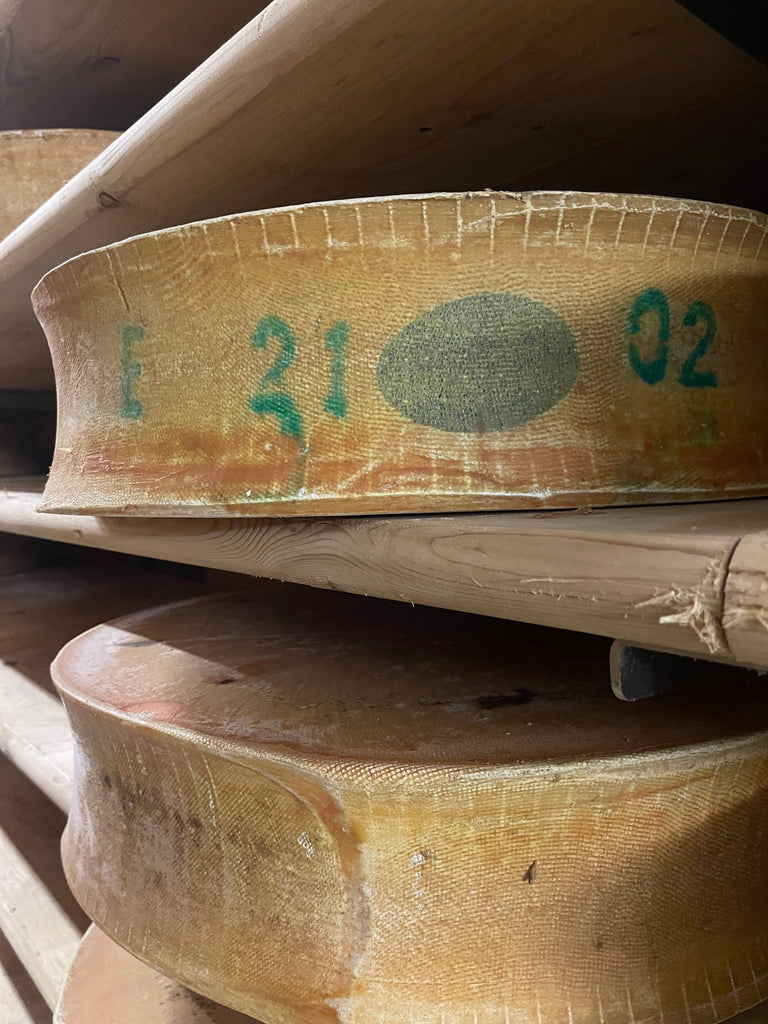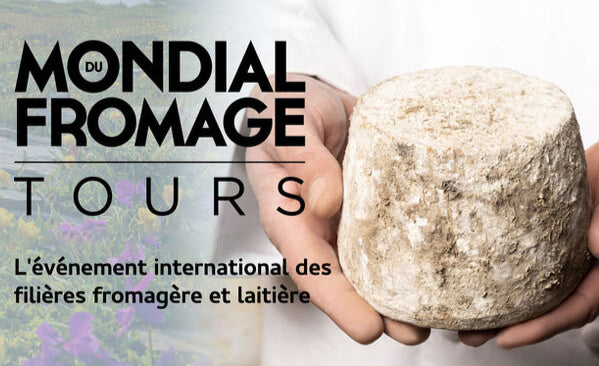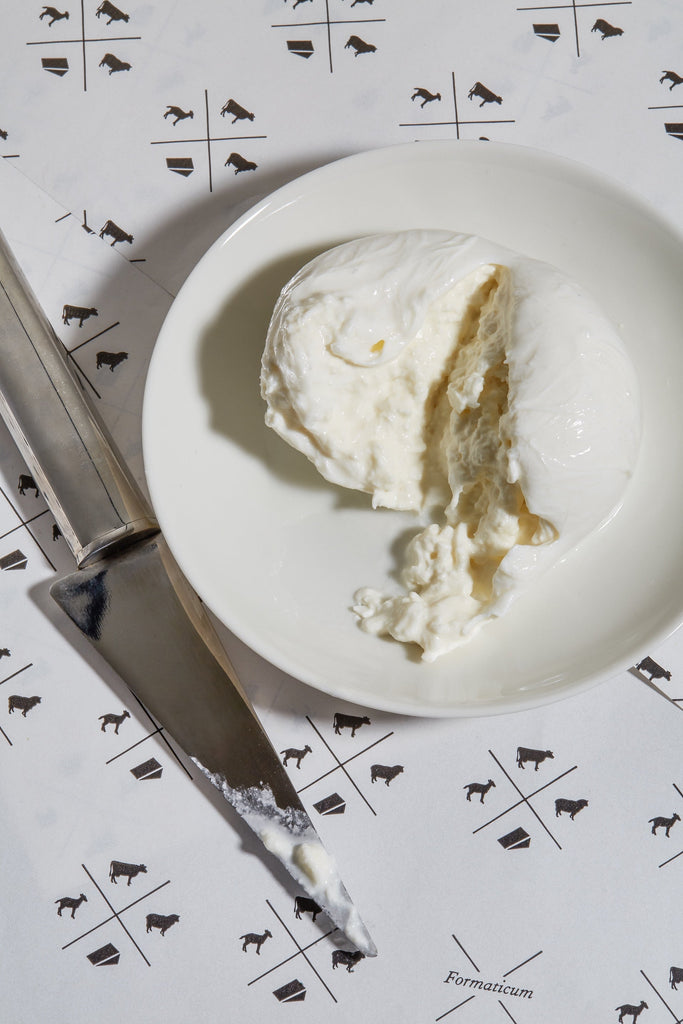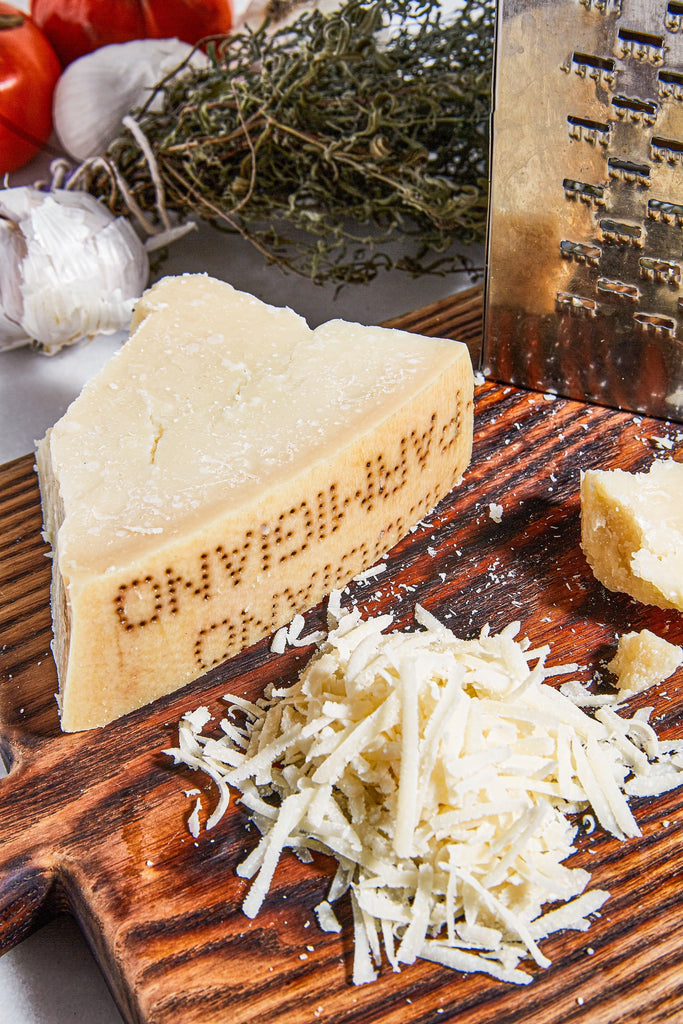Formaticum in France: Go For Beaufort


Earlier in September, the Formaticum team set off on a journey through the Haute-Savoie and Savoie departments of France in search of renowned cheese and delectable meals. One of our stops was the Coopérative Laitière de Moûtiers, a creamery known for their selection of traditional cheeses and products from the Savoie. But one cheese reigns supreme here - Beaufort AOP (pronounced bow-four). This behemoth wheel's size and signature concave rind makes it instantly recognizable among the other specialties of the surrounding areas, such as Abondance, Reblochon, Emmental de Savoie, and Tomme de Savoie. Beaufort is a classic mountain cheese, with summer profiles tasting funky and floral, and winter wheels leaning more towards savory onion notes.

Of course we were excited to taste the cheese, but we also wanted to get a closer look at the production of this iconic French fromage. We arrived around 9am, as the massive copper vats were beginning to fill with fresh milk from the local Tarine and Abondance breeds of cow, who feed only on hay and grass from the area of designation. Like many mountain cheeses from this area, Beaufort is a raw milk cheese, allowing the terroir of the Savoie to really shine. The milk for Beaufort is also not skimmed. We watched as the rennet was added to coagulate the milk, and as the curds were cut into tiny rice grain-sized pieces and cooked to encourage whey expulsion, which helps create that harder, drier texture in the cheese. While we couldn't stay to watch the whole process, we did get a quick look at the cheesecloth-lined molds used for pressing, including the traditional "belt" used to create the signature concave rind.

Before we left, we snuck a peek into the aging caves below the creamery, housing hundreds of wheels of Beaufort, slowly aging to perfection among both newly renovated and original rooms. While the minimum age for Beaufort AOP is 5 months, most of these wheels will be aged to 12 months or older to fully develop its peak flavor. The endless rows of rosy orange rinds was quite a sight to behold, and the smell was unforgettable.
We each purchased a kilo of seasonal Beaufort d'étè and some other regional delicacies, and got back on the road on our journey through the Alps to Northern Italy.
 In the US, Beaufort is a fairly rare cheese to see on a counter, due to its size and price point. However, many shops will bring some in for the holidays, as it is perfect for decadent celebratory spreads, as well as cozy recipes like fondue, mac and cheese, and potato gratin or dauphinoise. But Beaufort can be a finicky cheese, and must be cared for and stored properly in order to preserve its delicate flavor. While the shop's packaging kept the cheese safe in transit, I did transfer the cheese to a Formaticum Cheese Storage Bag as soon as I returned home to the US, where I made the discovery that a Classic Cheese Storage Bag is actually the perfect size for 1 kilo of Beaufort! They also make the perfect gift for the cheese lover in your life, and are available to order through our website or Amazon storefront.
In the US, Beaufort is a fairly rare cheese to see on a counter, due to its size and price point. However, many shops will bring some in for the holidays, as it is perfect for decadent celebratory spreads, as well as cozy recipes like fondue, mac and cheese, and potato gratin or dauphinoise. But Beaufort can be a finicky cheese, and must be cared for and stored properly in order to preserve its delicate flavor. While the shop's packaging kept the cheese safe in transit, I did transfer the cheese to a Formaticum Cheese Storage Bag as soon as I returned home to the US, where I made the discovery that a Classic Cheese Storage Bag is actually the perfect size for 1 kilo of Beaufort! They also make the perfect gift for the cheese lover in your life, and are available to order through our website or Amazon storefront. Cheesemonger Champions: Team USA's Journey to the Mondial du Fromage

Did you know that there are cheesemonger competitions? It's true! Your friendly neighborhood cheesemonger or shop owner might just be a nationally (or globally!) celebrated cheese champion.

Formaticum is proud to announce that earlier this year, Formaticum's Sales & Marketing Manager Emilia D'Albero took 1st place in the Cheesemonger Invitational: Masters competition, earning the title of the country's best cheesemonger for 2025. D'Albero, alongside runner-up Courtney Johnson from Seattle, will represent the United States at the Mondial du Fromage in France this September, essentially the World Cheese Olympics. D'Albero (ACS CCP) and Johnson (ACS CCP, CCSE, PhD) make up the very first all-female Team USA, and Johnson is only the second American to qualify to compete in the Mondial du Fromage twice, having competed in 2023 as well.

The Mondial du Fromage is biannual competition that takes place in Tours, France, and this year's competition features cheesemongers from 15 countries, all working towards the coveted title of World's Best Cheesemonger. For Americans, the opportunity to compete on the world stage is earned through 2 victories: first, a monger must place in the top 3 at the annual Cheesemonger Invitational. Then, they must earn one of the top 2 spots in the biannual Cheesemonger Invitational: Masters competition, where the top 3 mongers from past CMI events are invited to compete against other CMI winners in hopes of hearing their name called to join Team USA. Both of these events are open to the public and all cheese lovers are encouraged to attend!
The Masters competition mirrors the format of the Mondial du Fromage - 9 individual challenges, designed to test cheesemongers across all aspects of their work, including a written test on general cheese knowledge, a 5 minute oral presentation of a cheese of their choice, a blind tasting of 4 PDO cheeses cut in 1cm square (rindless!) pieces, and a perfect .5lb cut challenge involving mystery cheese and absolutely no access to a scale. The day culminates in the notorious Group 3 Challenges - a 4 hour marathon of cheesemongering, where contestants must put together a restaurant quality cheese plate using cheeses revealed only at the start of the test, assemble perfectly paired bites, present a cold dish that transforms an assigned cheese, build an intricate cheese sculpture, and design and assemble a 1 square meter themed cheese display using over 100lb of provided mystery cheeses. The esteemed panel of judges is comprised of top cheese industry professionals from all over the world, providing a variety of viewpoints formed over their combined decades of experience.

In September, Emilia and Formaticum founder Mark Goldman will travel to France alongside Courtney and team coach and CMI founder Adam Moskowitz of Maker to Monger. They will be joined by Maker to Monger's sensory education expert Alex Armstrong and CMI 2021 champion Tommy Amorim of Di Bruno Bros. for support and additional coaching. Having trained for this competition for nearly a year, their goal is simple - for both Emilia and Courtney to be on the podium this year, hopefully with one of them holding the gold medal, as an American monger has never won the Mondial du Fromage…yet.
What does training for the Mondial du Fromage entail? Since November 2024, D'Albero and Johnson have been in constant contact, discussing their ideas, organizing small details like supplies and tools, sharing study resources, and providing each other with emotional support. Both mongers have dedicated a minimum of 2 hours a day to preparing, whether that means recipe testing, studying flashcards, weekly blind tastings, or seemingly endless practice cutting cheese in creative and artistic ways to wow the judges. They have received many generous donations of cheese and other accoutrements from some of the USA's finest cheesemakers and artisans, and they are so thankful to the cheese industry as a whole for the incredible outpouring of support in the past few months. Both competitors have quite literally put their blood, sweat, and tears into this training and are looking forward to giving their absolute best effort and showing the world what American cheesemongers can do!

And if you're wondering what's in a champion's toolkit, don't worry - we'll give you an inside look. D'Albero trusts Formaticum Professional Cheese Knives with Plastic Handles to get those perfect cuts, and even boasts a custom-branded set of Formaticum Parmigiano Reggiano knives. You will never catch her without her 5" Wire Cutter either - simply the best tool for the cleanest, quickest cuts on delicate or soft cheeses. Back in Seattle at her cut-to-order cheese shop Street Cheese, Johnson has her own Professional 4-Knife Set, and also wraps her customers' cheese in Formaticum Reusable Wrap and Classic Sheets. Of course, the unimaginable amount of cheese in Team USA's fridges are wrapped in Formaticum paper, keeping fresh for cutting and tasting practice.
Follow Team USA's journey to Mondial on Instagram (Emilia's profile and Courtney's profile) and keep an eye on the Formaticum account as well, since we'll be chronicling all our adventures in France, including exclusive cheesemaker tours, cheese shop visits, and more!
And of course, all Formaticum cheese storage products are available to order on formaticum.com so that you can store cheese like a champion.
Breaking Down Burrata: A Guide to Mozzarella & Friends

Summer is approaching, bringing with it the season of stone fruits, melons, summer squash, heirloom tomatoes, and more - all perfect for a light and fresh seasonal caprese salad. Many believe that the caprese salad is restricted to tomatoes and mozzarella only, but a uniquely seasonal caprese salad is one of the biggest joys of the summertime. Fresh mozzarella is a classic, but what about other fresh cheeses? What's the difference between mozzarella and burrata anyway? Let's break it down:
Mozzarella is a stretched-curd, or pasta filata-style cheese that originated in Southern Italy. Rather than cutting the curd into small pieces and pressing them into a mold, large pieces of curd are submerged in hot water to make them pliable, then stretched and rolled into itself to form the signature ball shape. The balls are pinched off (the word mozzarella comes from the verb mozzare, meaning "to pinch") and held in cold water to set the shape.
Fresh mozzarella made with cow's milk if typically known as fiordilatte, or "flower of milk" due to its fresh, sweet flavor. Low-moisture loaf versions are common in the USA and sometimes known as "pizza cheese" because of its ability to melt on pizza without creating soggy crust.
Mozzarella di Bufala is a PDO product from the region of Campania in Italy. It is made from the milk of the water buffalo, which contains much higher levels of butterfat than standard cow's milk. The buffalo's milk gives Mozzarella di Bufala a creamy, tangy flavor and a rich, luscious texture. If you like fresh mozzarella, this is a must-try!
Stracciatella is made by shredding mozzarella curd and mixing it with heavy cream. The name refers to the "little rags" that the shreds resemble. It is typically used for making burrata but can also be utilized in salads or sandwiches.
Burrata is made by stretching mozzarella curd and filling it with stracciatella, and sealing it at the top to create a decadent, creamy treat. Burrata means "buttered," referring to the rich flavor profile as a result of the addition of the heavy cream.
Quesillo is a stretched-curd cheese from Mexico, very similar to mozzarella, but instead of a homogenous texture through, the curd is stretched into one thin strand and rolled onto itself until it looks almost like a delicious ball of yarn. You can substitute Quesillo (also known as Queso Oaxaca) for any recipe that calls for fresh or low-moisture mozzarella.
One of our favorite dishes in the Formaticum test kitchen is a stone fruit caprese, with grilled ripe peaches or nectarines, topped with torn burrata, fresh basil, and a drizzle of good extra virgin olive oil.
Fresh cheeses like mozzarella have high moisture content and should be consumed within a few days of purchase for the best possible flavor and texture. Formaticum Reusable Cheese Storage Sheets can extend the life of your cheese by an extra few days, and provide a leakproof solution for cheese storage if you're unable to store these cheeses in their original liquid or packaging.
Shop all Professional Cheese Storage solutions on our website now!
Do you have a favorite way to eat fresh cheese during the summertime? Email us at hello@formaticum.com to let us know, and we might feature it in a future blog post or social media post!
The Versatility of Cheese

Cheese is one of the most widely consumed foods all over the globe, and it's also one of the most versatile fermented foods available. It has origins in the Fertile Crescent, and people across all cultures have incorporated various types of fermented dairy products into their diets for thousands of years. There are no rules when it comes to eating and enjoying cheese - and while some recipes and dishes can be considered classics, there is always a new way to expand your horizons and include cheese in everything you do in the kitchen. Here are some of our favorite, and perhaps unexpected, ways that the folks here at Formaticum incorporate cheese into our every day lives:
- A good cream cheese, farmer's cheese, or cottage cheese can be spread on a piece of toasted sourdough and topped with extra virgin olive oil and flaky salt, thick-cut heirloom tomatoes, and even a few strips of crispy bacon.
- Cheese with fish? The Italians may consider this blasphemy, but a briny Pecorino Romano or Pecorino Sicilian is the perfect garnish for a pasta or risotto with mussels or clams.
- A plate with a few chunks of Cheddar or Gruyère, apple slices, and some almonds or cashews is a balanced and filling mid-afternoon snack.
- Did you know that Vermont Cheddar and Vermont maple syrup are a perfect pairing? This information comes straight from our friends at Shelburne Farms, where both products are produced - they're obviously the experts!
- A friend of Formaticum from Quesos Navarro out of Mexico recommended pan-frying slices of Panela and drizzling them with honey for a sweet treat.
- A stretched-curd cheese like Quesillo or Queso Oaxaca can be substituted in any recipe that calls for mozzarella.
- Is your fridge full of forgotten odds and ends of various cheeses? Sounds like it's time to make some French-inspired Fromage Fort!
- Drain a few cups of Greek yogurt in cheesecloth overnight to make Middle Eastern labneh, which can be mixed with good olive oil and your favorite spice blend and eaten as an incredible dip with fresh pita or your favorite crackers.
- Parmigiano Reggiano, aka the King of Cheese, is more than just a grating cheese - the Italians love to eat chunks as a snack or table cheese, or drizzled with balsamic vinegar. You can also bake grated Parmigiano Reggiano until crunchy, creating satisfying cheesy chips called Frico, and don't throw away those rinds! Throw them into a soup, sauce, or stock for an extra level of savory umami.
- Blue cheese leftovers can be combined with sour cream and other spices for a quick homemade blue cheese dressing, or even a blue cheese sauce for your next steak dinner.
- If you serve a cheese plate at a dinner party or get-together and not all the cheese is eaten, don't put it back in the fridge - keep it under a glass cloche on the counter overnight and enjoy it for breakfast with some toast or melted into your eggs.
- Speaking of eggs, a soft scramble is easily elevated by whisking in or crumbling some fresh chèvre/goat cheese for a bright, tangy, creaminess.
No matter how you use cheese, the most important thing to do is to store it properly to keep the flavor at its peak, whenever you eat it. Our new Reusable Cheese Storage Bags and Sheets provide our strongest and most effective cheese protection yet, and are suitable for all styles of cheese.
Do you have a favorite way to use cheese that we did not mention? Send us an email at hello@formaticum.com and we will give it a try in the Formaticum test kitchen!

Formaticum News
Our home to share our cheese chronicles and more.
Categories
Recent Posts
Formaticum in France: Go For Beaufort
Cheesemonger Champions: Team USA's Journey to the Mondial du Fromage
Breaking Down Burrata: A Guide to Mozzarella & Friends
Upcoming Events
Connect with Us
Join the Newsletter
Sign up to receive special offers, new product releases, updates from the cheese shop, and more.









